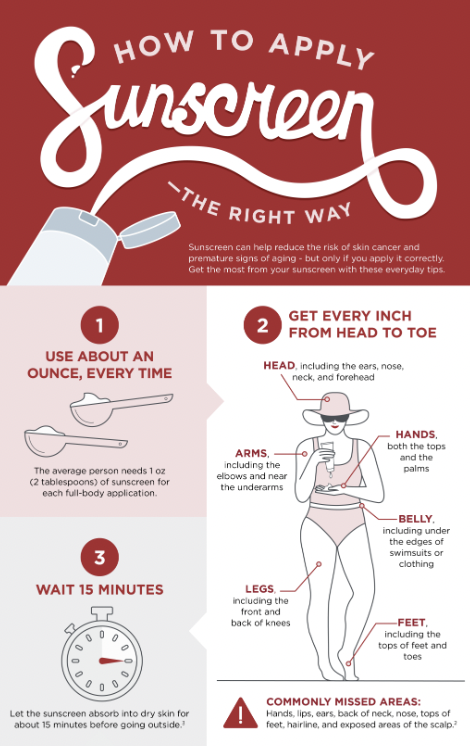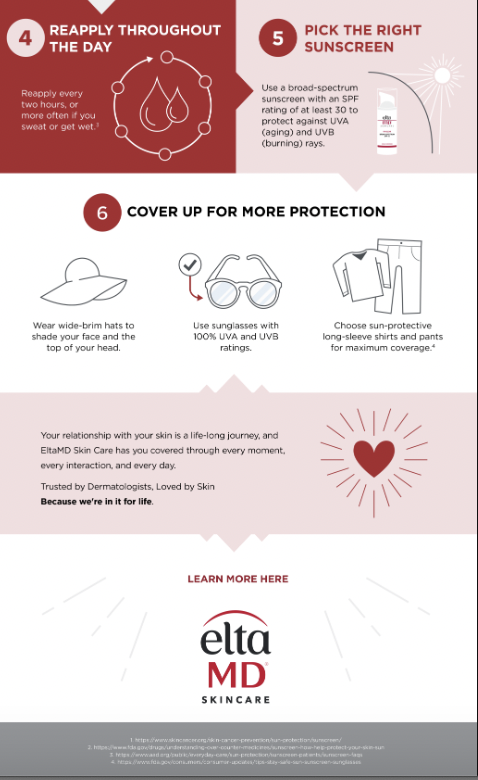Skin care needs vary from person to person, but there's one thing we all have in common: sunscreen. Sunscreen is powerful stuff, and regular use can protect you from a host of issues. According to the Skin Cancer Foundation, it can help reduce your risk of skin cancers by up to 50 percent, and it also helps prevent wrinkles, sunken skin, and age spots.
But for all it does to help the skin, many people don't know how to apply sunscreen—and improper use can shortchange you of its benefits. The American Academy of Dermatology reports that 42 percent of people either don't reapply sunscreen at all or only reapply if they get wet.
So, do you know how to apply sunscreen? Read on to become a sun care pro.
Best Practices for How to Apply Sunscreen
Despite your best intentions, it can be easy to slip into bad habits and lose out on the preventive power of sunscreen. But by following these best practices, you'll be well on your way to improving your skin health.
Use the Right Amount
Understanding the right way to apply sunscreen starts with how much to use. So, what is the right amount of sunscreen? Most people should use about an ounce (two tablespoons) of sunscreen for a single full-body application, though you may need more depending on your size. Use the same amount for each reapplication, even with spray sunscreen.
If that sounds like overkill, the science begs to differ: In one study, researchers compared "typical" sunscreen use with the (higher) recommended amount—about two milligrams of thickness per centimeter of surface area. Results showed that people who spread their sunscreen too thinly didn't get full protection. These users had more skin damage in one day of sun exposure than those who followed the suggested amount had in five.
When in doubt, apply liberally. What that means can depend on your specific needs—but it's probably more than you think. If you have any doubt, check with a board-certified Dermatologist to see what's right for you.
Cover Every Inch of Exposed Skin
Apply sunscreen to your whole body, head to toe, to avoid sun-damaged skin. Consumer Reports found that just one in three people manages to rub sunscreen on every inch of exposed skin. This can yield patchy burns and increase your risk of skin damage.
Watch out for these commonly overlooked areas:
- Nose, lips, and ears
- Back of the neck
- Tops of the feet
- Under the edges of clothing
- Hairlines, part lines, and balding or thinly covered areas of the scalp
Even if you're wearing clothing or a hat, experts still recommend doing a full-body application before you get dressed. This can help you stay protected if your clothing rides up or if you shed layers.
After rubbing the sunscreen in, wait 15 minutes before going outside. This gives it enough time to absorb into your skin.
Know How Often to Apply Sunscreen
Reapplying sunscreen is essential. After your first application of the day, keep the sunscreen bottle handy. You'll need it again in two hours or earlier.
With so many variables at play between your body and the environment, a higher SPF or an overcast day doesn't necessarily buy you more time between applications. Every sunscreen, no matter the weather, needs to be reapplied according to the instructions—usually every two hours or after getting wet or sweating. When reapplying sunscreen, always dry your skin first. Never apply sunscreen to wet skin.
If the sunscreen says it's "water-resistant," check the label for how long that resistance lasts in the water. It will either be 40 or 80 minutes but never longer.
With all those reapplications, you're bound to go through a lot of sunscreen, so remember to pack extra. A family of four will likely use up a full bottle in one afternoon.
Pick the Right Sunscreen
Before thinking about how to apply sunscreen, you have to find the right formula. Check the label for three things:
Broad-Spectrum
Broad-spectrum sunscreens protect against both UVA and UVB rays. UVA rays damage and prematurely age skin; UVB rays cause most sunburns. Too much of either can lead to skin cancer.
SPF 30 (or Higher)
A sunscreen's SPF, which stands for "sun protection factor," refers to its ultraviolet-blocking power and duration. SPF 30 protects the skin from 97 percent of UVB rays, for example. The percentage goes up from there, but no sunscreen can claim 100 percent protection. You can find a variety of sunscreen types with SPF 30 or higher. For example, EltaMD UV AOX Mist Broad-Spectrum SPF 40 marries air-powered, all-angle spray application with adequate sun protection.
Water-Resistant
While you'll still need to reapply frequently, these sunscreen formulas take longer to rinse off, providing better protection if you're swimming or sweating. The label will tell you how long the resistance lasts. For example, EltaMD UV Sport Broad-Spectrum SPF 50 can resist water for up to 80 minutes, and it won't drip into your eyes and cause irritation.
Try different sunscreens to find your favorite: you'll be using it often, so pick something you like! If you're looking to cover all your bases, try a formula like EltaMD UV Active Broad-Spectrum SPF 50+, which offers all these benefits in a lightweight, nonirritating formula.
Take Time to Get It Right to Prevent Sun-Damaged Skin
Even if you don't expect to be outdoors for long (or at all), make it a habit to grab sunscreen just in case and maybe extra coverings like a wide-brimmed hat, long-sleeved shirts, and pants for maximum coverage. Sunglasses with 100 percent UVA and UVB ratings are important, too. Keeping these items in your bag or car will help ensure you're never left unprotected.
It may take a little extra effort to get right, but it's worth it. Applying and reapplying your sunscreen correctly can make a bigger difference than you might think in supporting your skin health and preventing sun-damaged skin.

